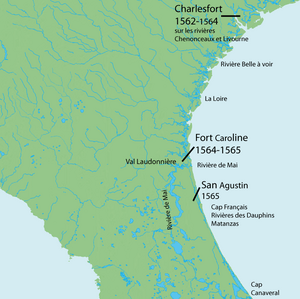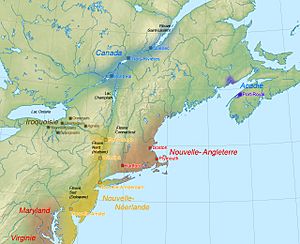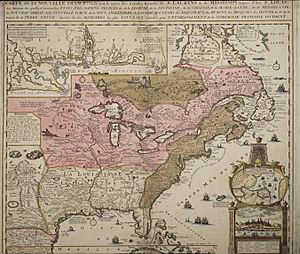French colonization of the Americas facts for kids
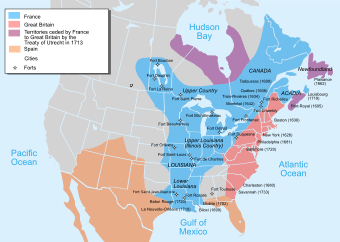
The French colonization of the Americas began in the 16th century, and continued on into the following centuries as France established a colonial empire in the Western Hemisphere. France founded colonies in much of eastern North America, on a number of Caribbean islands, and in South America. Most colonies were developed to export products such as fish, sugar, and furs.
As they colonized the New World, the French established forts and settlements that would become such cities as Quebec and Montreal in Canada; Detroit, Green Bay, St. Louis, Cape Girardeau, Mobile, Biloxi, Baton Rouge and New Orleans in the United States; and Port-au-Prince, Cap-Haïtien (founded as Cap-Français) in Haiti, Cayenne in French Guiana and São Luís (founded as Saint-Louis de Maragnan) in Brazil.
Contents
North America
Background
The French first came to the New World as explorers, seeking a route to the Pacific Ocean and wealth. Major French exploration of North America began under the rule of Francis I, King of France. In 1524, Francis sent Italian-born Giovanni da Verrazzano to explore the region between Florida and Newfoundland for a route to the Pacific Ocean. Verrazzano gave the names Francesca and Nova Gallia to that land between New Spain and English Newfoundland, thus promoting French interests.
Colonization
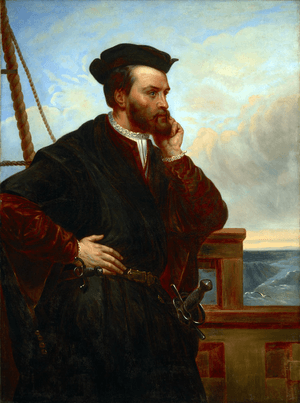
In 1534, Francis I of France sent Jacques Cartier on the first of three voyages to explore the coast of Newfoundland and the St. Lawrence River. He founded New France by planting a cross on the shore of the Gaspé Peninsula. The French subsequently tried to establish several colonies throughout North America that failed, due to weather, disease, or conflict with other European powers. Cartier attempted to create the first permanent European settlement in North America at Cap-Rouge (Quebec City) in 1541 with 400 settlers but the settlement was abandoned the next year after bad weather and first nations attacks. A small group of French troops were left on Parris Island, South Carolina in 1562 to build Charlesfort, but left after a year when they were not resupplied by France. Fort Caroline established in present-day Jacksonville, Florida in 1564, lasted only a year before being destroyed by the Spanish from St. Augustine. An attempt to settle convicts on Sable Island off Nova Scotia in 1598 failed after a short time. In 1599, a sixteen-person trading post was established in Tadoussac (in present-day Quebec), of which only five men survived the first winter. In 1604, Saint Croix Island in Acadia was the site of a short-lived French colony, much plagued by illness, perhaps scurvy. The following year the settlement was moved to Port Royal. Samuel de Champlain founded Quebec (1608) and explored the Great Lakes. In 1634, Jean Nicolet founded La Baye des Puants (present-day Green Bay), which is one of the oldest permanent European settlements in America. In 1634, Sieur de Laviolette founded Trois-Rivières. In 1642, Paul de Chomedey, Sieur de Maisonneuve, founded Ville-Marie which is now known as Montreal. Louis Jolliet and Jacques Marquette founded Sault Sainte Marie (1668) and Saint Ignace (1671) and explored the Mississippi River. At the end of the 17th century, René-Robert Cavelier, Sieur de La Salle established a network of forts going from the Gulf of Mexico to the Great Lakes and the Saint Lawrence River. Fort Saint Louis was established in Texas in 1685, but was gone by 1688. Antoine de la Mothe Cadillac founded Fort Pontchartrain du Détroit (modern-day Detroit) in 1701 and Jean-Baptiste Le Moyne, Sieur de Bienville founded La Nouvelle Orléans (New Orleans) in 1718. Pierre Le Moyne d'Iberville founded Baton Rouge in 1719.
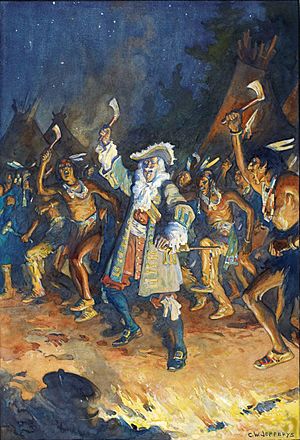
The French were eager to explore North America but New France remained largely unpopulated. Due to the lack of women, intermarriages between French and Indians were frequent, giving rise to the Métis people. Relations between the French and Indians were usually peaceful. As the 19th-century historian Francis Parkman stated:
"Spanish civilization crushed the Indian; English civilization scorned and neglected him; French civilization embraced and cherished him"
—Francis Parkman.
To boost the French population, Cardinal Richelieu issued an act declaring that Indians converted to Catholicism were considered as "natural Frenchmen" by the Ordonnance of 1627:
"The descendants of the French who are accustomed to this country [New France], together with all the Indians who will be brought to the knowledge of the faith and will profess it, shall be deemed and renowned natural Frenchmen, and as such may come to live in France when they want, and acquire, donate, and succeed and accept donations and legacies, just as true French subjects, without being required to take no letters of declaration of naturalization."
Louis XIV also tried to increased the population by sending approximately 800 young women nicknamed the "King's Daughters". However, the low density of population in New France remained a very persistent problem. At the beginning of the French and Indian War (1754–1763), the British population in North America outnumbered the French 20 to 1. France fought a total of six colonial wars in North America (see the four French and Indian Wars as well as Father Rale's War and Father Le Loutre's War).
French Florida
In 1562, Charles IX, under the leadership of Admiral Gaspard de Coligny sends Jean Ribault and a group of Huguenot settlers in an attempt to colonize the Atlantic coast and found a colony on a territory which will take the name of the French Florida. They discover the probe and Port Royal Island, which will be called by Parris Island in South Carolina, on which he built a fort named Charlesfort. The group, led by René Goulaine de Laudonnière, moved to the south where they founded the Fort Caroline on the Saint John's river in Florida on June 22, 1564. This irritated the Spanish who claimed Florida and oppose the Protestant settlers for religious reasons. In 1565, Pedro Menéndez de Avilés led a group of Spaniards and founded Saint Augustine, 60 kilometers south of Fort Caroline. Fearing a Spanish attack, Ribault planned to move the colony but a storm suddenly destroyed his fleet. On 20 September 1565 the Spaniards, commanded by Menéndez de Avilés, attacked and massacre all the Carolina occupants including Jean Ribaut.
Canada and Acadia
The French interest in Canada focuses first on the fishing off the Grand Banks of Newfoundland. However, at the beginning of the 17th century, France was more interested in fur from North America. The fur trading post of Tadoussac was founded in 1600. Four years later, Champlain made his first trip to Canada in a trade mission for fur. Although he had no formal mandate on this trip, he sketched a map of the St. Lawrence River and in writing, on his return to France, a report entitled Savages (Relation of his stay in a tribe of Montagnais near Tadoussac).
Champlain needed to report his findings to Henry IV. He participated in another expedition to New France in the spring of 1604, conducted by Pierre Du Gua de Monts. It helped the foundation a settlement on Saint Croix Island, the first French settlement in the New World, which will be given up the following winter. The expedition then founded the colony of Port-Royal.
In 1608, Champlain founded a fur post that will become the city of Quebec, which will become the capital of New France. In Quebec, Champlain forged alliances between France and the Huron and Ottawa against their traditional enemies, the Iroquois. Champlain and other French travelers then continued to explore North America, with the canoe made from the bark of Birch, to move quickly through the Great Lakes and their tributaries. In 1634, the Normand explorer Jean Nicolet pushed his exploration to the West up to the state of Wisconsin.
Following the capitulation of Quebec by the Kirke brothers, the British occupied the city of Quebec and that of Canada from 1629 to 1632. Samuel de Champlain was taken prisoner and there followed the bankruptcy of Company of One Hundred Associates. Following the Treaty of Saint-Germain-en-Laye, France took possession of the colony in 1632. The city of Trois-Rivières was founded in 1634. In 1642, the Angevin Jérôme le Royer de la Dauversière founded Ville-Marie (later Montreal) which was at that time, a fort as protection against Iroquois attacks (the first great Iroquois war lasted from 1642 to 1667).
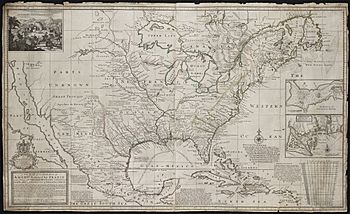
Despite this rapid expansion, the colony developed very slowly. The Iroquois wars and diseases were the leading causes of death in the French colony. In 1663 when Louis XIV provided the Royal Government, the population of New France was only 2500 European inhabitants. That year, to increase the population, Louis XIV sent between 800 and 900 'King's Daughters' to become the wives of French settlers. The population of New France reached subsequently 7000 in 1674 and 15000 in 1689.
From 1689 to 1713, the French settlers were faced with almost incessant war during the French and Indian Wars. From 1689 to 1697, they fought the British in the Nine Years' War. The war against the Iroquois continued even after the Treaty of Rijswijk until 1701, when the two parties agreed on peace. Then, the war against the English took over in the War of the Spanish Succession. In 1690 and 1711, Quebec City had successfully resisted the attacks of the English navy and then British army. Nevertheless, the British took advantage of the second war. With the signing of the Treaty of Utrecht in 1713, France ceded to Britain Acadia (with a population of 1700 people), Newfoundland and Hudson Bay.
Under the Sovereign Council, the population of the colony grew faster. However, the population rate was far from being equivalent to what was happening in the British Thirteen Colonies to the south. In the middle of the 18th century, New France accounted for 60,000 people while the British colonies had more than one million people. This placed the colony at a great military disadvantage against the British. The war between the colonies resumed in 1744, lasting until 1748. A final and decisive war began in 1754. The Canadiens and the French were helped by numerous alliances with Native Americans, but they were usually outnumbered on the battlefield.
Louisiana
On May 17, 1673, explorers Louis Jolliet and Jacques Marquette began exploring the Mississippi River, known to the Sioux as does Tongo, or to the Miami-Illinois as missisipioui (the great river). They reached the mouth of the Arkansas and then up the river, after learning that it flowed into the Gulf of Mexico and not to the California Sea (Pacific Ocean).
In 1682, the Normand Cavelier de la Salle and the Italian Henri de Tonti came down the Mississippi to its Delta. They left from Fort Crevecoeur on the Illinois River, along with 23 French and 18 Native Americans. In April 1682, they arrived at the mouth of the Mississippi; they planted a cross and a column bearing the arms of the king of France. Going back through the same route to Canada, La Salle returned to Versailles. There he wins over the Minister of the Navy to give him the command of Louisiana. He does believe that it is close to the New Spain by drawing a map on which the Mississippi seemed much further west than its actual rate. He set up a maritime expedition with four ships and 320 emigrants, but it ended in disaster when he failed to find the Mississippi Delta and was killed in 1687.
In 1698, Pierre LeMoyne d'Iberville left La Rochelle and explored the area around the mouth of the Mississippi. He stopped between Isle-aux-Chats (now Cat Island) and Isle Surgeres (renamed Isle-aux-Vascular or Ship Island) on February 13, 1699 and continued his explorations to the mainland, with his brother Jean-Baptiste Le Moyne de Bienville to Biloxi. He built a precarious fort, called 'Maurepas' (later 'Old Biloxi'), before returning to France. He returned twice in the Gulf of Mexico and established a fort at Mobile in 1702.
From 1699 to 1702, Pierre Le Moyne d'Iberville is governor of Louisiana. His brother succeeded him in that post from 1702 to 1713. He is again governor from 1716 to 1724 and again 1733 to 1743. In 1718, Jean-Baptiste Le Moyne de Bienville commanded a French expedition in Louisiana. He founded the city of New Orleans, in homage to Regent Duke of Orleans. The architect Adrian de Pauger drew the orthogonal plane of the Old Square.
Dissolution
The last French and Indian War resulted in the dissolution of New France, with Canada going to Great Britain and Louisiana going to Spain. Only the islands of Saint-Pierre-et-Miquelon have remained in French hands until today.
In 1802 Spain returned Louisiana to France, but Napoleon sold it to the United States in 1803. The French left many toponyms (Illinois, Vermont, Bayous...) and ethnonyms (Sioux, Coeur d'Alene, Nez Percé...) in North America.
West Indies
A major French settlement lay on the island of Hispaniola, where France established the colony of Saint-Domingue on the western third of the island in 1664. Nicknamed the "Pearl of the Antilles", Saint-Domingue became the richest colony in the Caribbean due to slave plantation production of sugar cane. It had the highest slave mortality rate in the western hemisphere. A 1791 slave revolt, the only ever successful slave revolt, began the Haitian Revolution, led to freedom for the colony's slaves in 1794 and, a decade later, complete independence for the country, which renamed itself Haiti. France briefly also ruled the eastern portion of the island, which is now the Dominican Republic.
During the 17th and 18th centuries, France ruled much of the Lesser Antilles at various times. Islands that came under French rule during part or all of this time include Dominica, Grenada, Guadeloupe, Marie-Galante, Martinique, St. Barthélemy, St. Croix, St. Kitts, St. Lucia, St. Martin, St. Vincent and Tobago. Control of many of these islands was contested between the French, the British and the Dutch; in the case of St. Martin, the island was divided in two, a situation that persists to this day. Great Britain captured some of France's islands during the Seven Years' War and the Napoleonic Wars. Following the latter conflict, France retained control of Guadeloupe, Martinique, Marie-Galante, St. Barthélemy, and its portion of St. Martin; all remain part of France today. Guadeloupe (including Marie-Galante and other nearby islands) and Martinique each is an overseas department of France, while St. Barthélemy and St. Martin each became an overseas collectivity of France in 2007.
South America
From 1555 to 1567, French Huguenots, under the leadership of vice-admiral Nicolas Durand de Villegaignon, made an attempt to establish the colony of France Antarctique in what is now Brazil, but were expelled. From 1612 to 1615, a second failed attempt (France Équinoxiale) was made in present-day São Luís, Brazil.
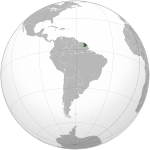
French Guiana was first settled by the French in 1604, although its earliest settlements were abandoned in the face of hostilities from the indigenous population and tropical diseases. The settlement of Cayenne was established in 1643, but was abandoned. It was re-established in the 1660s. Except for brief occupations by the English and Dutch in the 17th century, and by the Portuguese in the 19th century, Guiana has remained under French rule ever since. From 1851 to 1951 it was the site of a notorious penal colony, Devil's Island (Île du Diable). Since 1946, French Guiana has been an overseas department of France.
In 1860, a French adventurer, Orelie-Antoine de Tounens proclaimed himself king of Araucania and Patagonia. His claim was not accepted by foreign powers and Chile and Argentina took firm control over the regions, treating him as insane.
Images for kids
-
Portrait of Jacques Cartier by Théophile Hamel, arr. 1844
See also
 In Spanish: Colonización francesa de América para niños
In Spanish: Colonización francesa de América para niños


